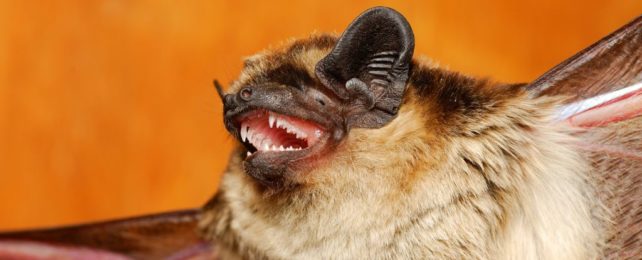When it comes to singing, bats have most species beat tooth over claw. Sure, their tunes might not be on everybody's top 20 list, but their cries span a tremendous frequency range of around 7 octaves from 1 to 120 kilohertz, rising well outside the range of human hearing.
Thanks to a new study of bat anatomy by researchers from the University of Southern Denmark, we now have a better idea about how they make them, and why.
At higher frequencies, bat calls are used for echolocation. Lower frequency cries are how bats talk to each other.
Fascinatingly, to make their lower pitched, growling calls, bats use structures in their throat analogous to those used by snarling death metal and Tuvan throat singers.
These are called ventricular folds, or false vocal folds, and bats seem to use them to produce sounds between 1 and 5 kilohertz, often in antagonistic situations. This seems to suggest that these calls are at least sometimes used to issue challenges or warnings to other bats.
"We identified for the first time what physical structures within the larynx oscillate to make their different vocalizations," says University of Southern Denmark biologist Coen Elemans.
"For example, bats can make low frequency calls, using their so-called 'false vocal folds' – like human death metal singers do."
In humans, the ventricular folds sit above the vocal folds, but are not directly involved in the production of normal speaking or singing sounds. It's thought that they help protect the vocal folds, assist in maintaining pressure, and possibly help shape the voice. It's only in specialist forms of vocalization – such as singing – that these folds are directly involved in sound production.
Most mammals, including humans, have a vocal range of about 3 to 4 octaves (although there are extreme exceptions). To find out how bats are able to produce a comparatively wide frequency range, Elemans and his team, led by Jonas Håkansson of the University of Southern Denmark, decided they needed to conduct some experiments.
They euthanized 8 adult specimens of wild-caught Daubenton's bats (Myotis daubentonii) and extracted their laryngeal apparatuses. Then, they mounted 5 of the larynxes in an experimental setup designed to reproduce the dynamics of vocalization, and applied a flow of air to create sound. All this was filmed at 250,000 frames per second to capture the tiniest nuances of sound production.
Machine learning was used to reconstruct the motion of vocal membranes that were obscured by other laryngeal structures.
The vocal cords, they found, vibrated at frequencies between 10 and 95 kilohertz. This is a range consistent with echolocation squeaks. The very highest calls are made using a micrometer-thin vocal membrane, a structure on the end of the vocal fold that our primate ancestors most likely had as well, but lost on the road to becoming human.
"We have directly filmed these vocal membranes for the first time," Håkansson explains.
"To show their vibrations we needed to film at extremely high rates, up to 250,000 frames per second. We see many adaptations in the larynx, that we think are responsible for the bat's ability to make very high frequency calls very fast, so that they can catch insects while flying."
However, the lowest frequencies, between 1 and 3 kilohertz, vibrated the ventricular folds. These, the team concluded, were most likely involved in the lower growls emitted by the bats.
It's not entirely clear what these growls mean. The researchers caught nine more bats and recorded them vocalizing. Only three of the bats growled: when they were either returned to the roost after weighing, or when stroked by a human. This could be a clue as to the growl's purpose, the researchers say.
"Some seem aggressive, some may be an expression of annoyance, and some may have a very different function," says biologist Lasse Jakobsen of the University of Southern Denmark. But, he added, "We don't know yet."
We're sure results of any future studies on bat vocalizations will be music to our ears.
The team's research has been published in PLOS Biology.
